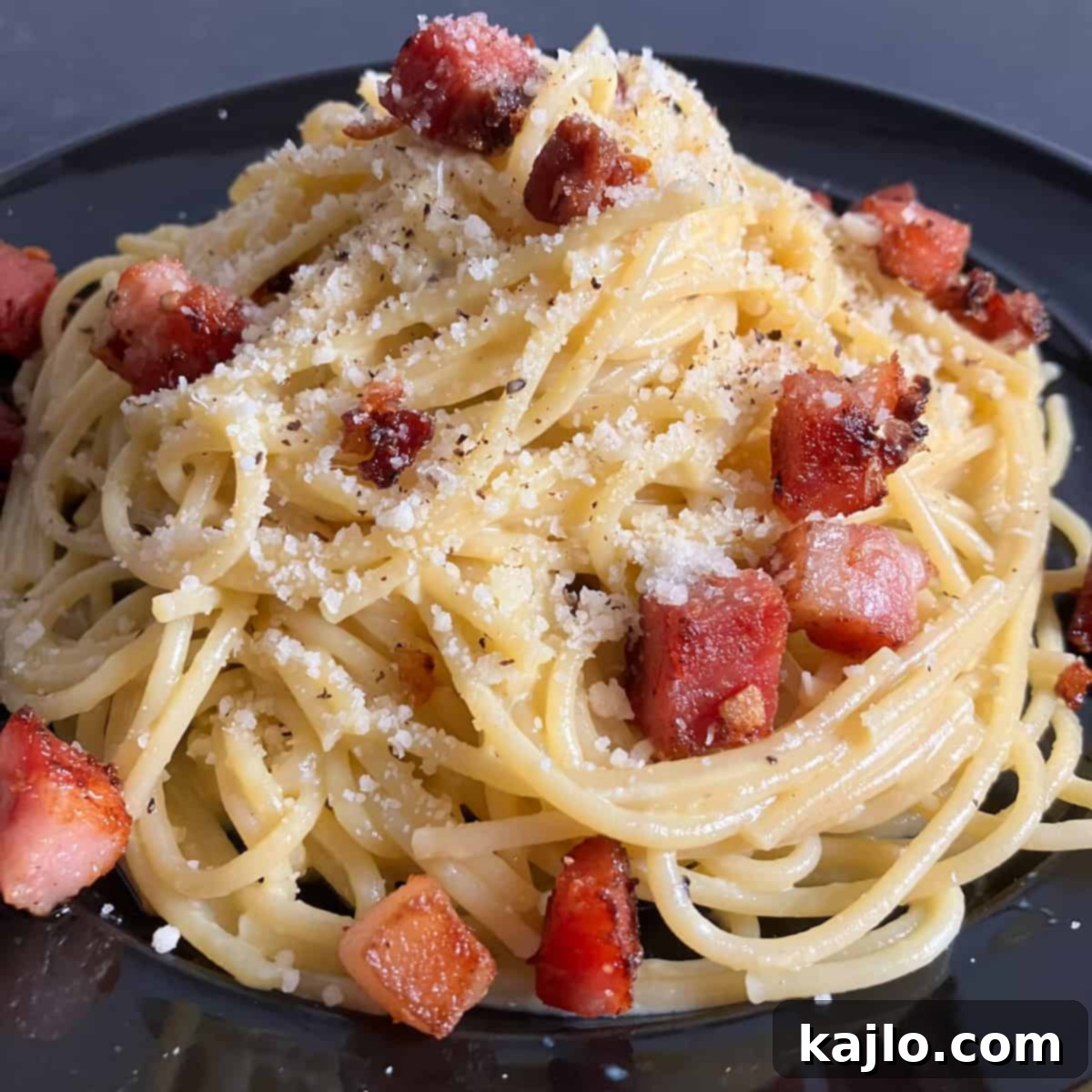Crispy Pork Belly Carbonara: An Irresistible, Easy Pasta Recipe
Prepare for a culinary delight with this incredibly simple yet profoundly flavorful **Pork Belly Pasta** recipe! Requiring just a handful of staple ingredients (plus salt and pepper), this dish transforms crispy leftover pork belly into a rich, creamy, and undeniably delicious **Pork Belly Carbonara**. It’s an Italian-inspired masterpiece that’s sure to become a beloved family favorite, perfect for any night of the week. Beyond this incredible pasta, we’ll also explore numerous creative ways to utilize leftover pork belly, ensuring no morsel goes to waste!

🍝 Mastering Pork Belly Pasta: The Essential Ingredients
Creating the ultimate **Pork Belly Pasta** begins with a selection of high-quality ingredients. This recipe is a testament to how simple components, when chosen carefully, can produce extraordinary results. Here’s what you’ll need to craft this unforgettable dish:
- 4 ounces cooked and diced pork belly (approximately 113 grams). Whether you use pre-cooked varieties, like the convenient Costco pork belly, or perfectly rendered crispy pork belly from a previous meal, the key is its irresistible texture and flavor.
- 2 cloves garlic, minced. Freshly minced garlic provides an aromatic foundation that perfectly complements the richness of the pork.
- 3 large eggs. These are the heart of our carbonara sauce, transforming into a silky, luscious emulsion with the hot pasta.
- ⅔ cup grated Parmesan cheese, packed (plus extra for serving). The quality of your cheese makes a significant difference. We highly recommend genuine Italian Parmigiano Reggiano for its deep, nutty, and savory notes.
- Salt and freshly ground black pepper, to taste. These fundamental seasonings elevate all the other flavors.
- 12 ounces spaghetti noodles, dry (approximately 340 grams). While spaghetti is traditional, feel free to use other long pasta shapes that hold sauce well.
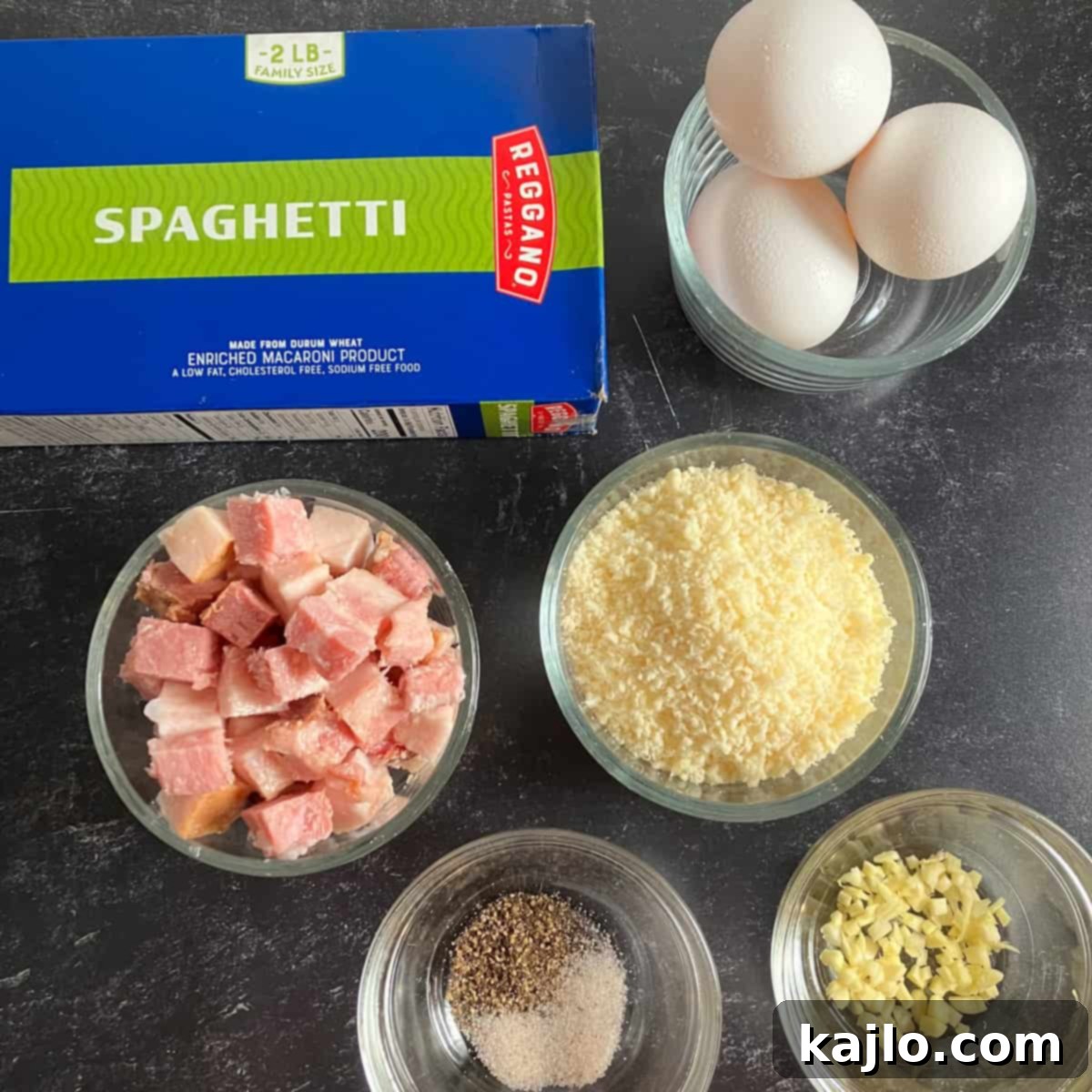
Ingredient Spotlight: The Importance of Quality
The success of an authentic carbonara hinges on the quality of its components, particularly the cheese. Our culinary tests have consistently shown that inexpensive, pre-grated “Parmesan” from discount stores simply doesn’t deliver the depth and complexity required for this dish. For the very best flavor and a truly creamy, emulsified sauce, investing in real Italian Parmigiano Reggiano is paramount. Its distinct granular texture and rich, umami profile are irreplaceable.
Conversely, while some pasta connoisseurs might disagree, we believe you can confidently use more budget-friendly spaghetti, provided it’s cooked perfectly al dente. The firm bite of properly cooked pasta is essential, regardless of brand. Ultimately, choose a pasta you love that fits your budget and culinary philosophy.
The magic of this creamy **Pork Belly Carbonara** sauce lies in the hot pasta gently cooking the raw eggs, creating a velvety coating rather than a scrambled mess. If you’re concerned about consuming undercooked egg whites, a simple substitution is to use 4-5 egg yolks instead of whole eggs. Many traditional carbonara recipes exclusively use yolks for a richer sauce. Alternatively, pasteurized shell eggs offer an added layer of safety without compromising flavor. Given that pork belly is wonderfully fatty, there’s absolutely no need to add olive oil or any other cooking oil to this recipe; the rendered pork fat provides all the richness you need.
Flavorful Twists: Pork Belly Carbonara Substitutions and Variations
This recipe adheres to the traditional “no cream” philosophy of Italian carbonara, where the luxurious sauce is created solely by the emulsion of egg, cheese, and starchy pasta water. While many American versions incorporate heavy cream for added richness, we found it entirely unnecessary here, especially when using high-quality Parmesan cheese. The natural fats from the pork belly, combined with the creamy emulsion, provide ample decadence.
For those who love to experiment, consider these delightful variations:
- Aromatic Additions: Sauté finely chopped onion with the pork belly and garlic for an extra layer of sweetness and depth.
- Earthy Notes: Incorporate sautéed mushrooms alongside the pork belly for a hearty **Pork Belly and Mushroom Pasta**.
- Spicy Kick: For a touch of heat, sprinkle red pepper flakes over the finished dish before serving.
- Herbal Freshness: Fresh parsley or chives, chopped and tossed in at the end, can add a vibrant pop of color and herbaceous flavor.
- Citrus Brightness: A hint of lemon zest grated over the top before serving can cut through the richness and add a refreshing note.
➕ Crafting Your Perfect Pork Belly Carbonara: A Step-by-Step Guide
Embark on the journey to create luscious **pasta with pork belly** with these easy-to-follow instructions. The key to a successful carbonara is precision and timing, ensuring that each component is prepared to perfection and combined at the right moment.
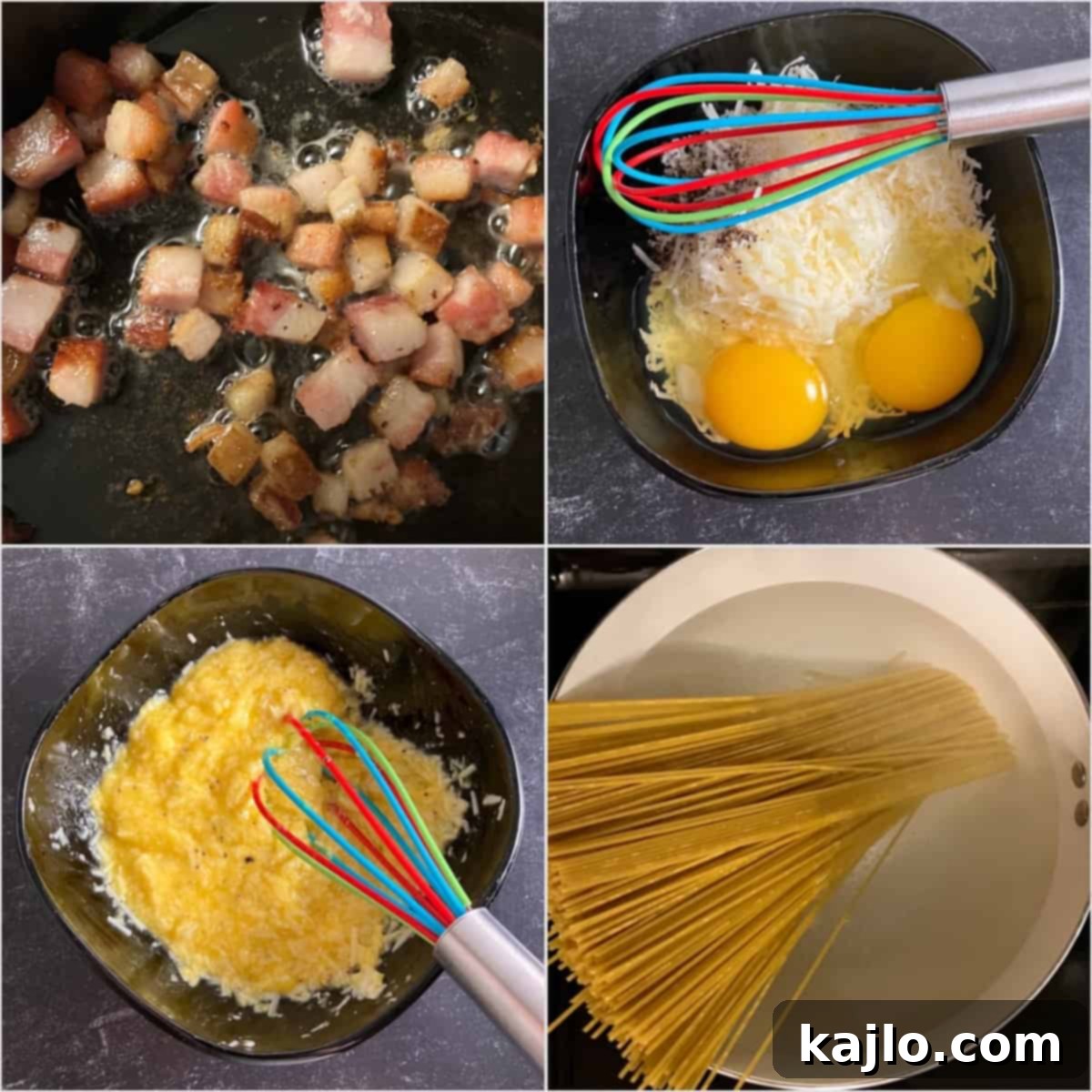
Prepare the Pork Belly: Begin by dicing your cooked pork belly into small, even pieces. Mince the garlic cloves. In a skillet or frying pan (a cast-iron skillet works wonderfully for even heat distribution and crisping), cook the diced pork belly over medium heat. Allow it to render its fat and become gloriously crisp. Once the pork belly is browned and crunchy, add the minced garlic and sauté for another minute until fragrant, being careful not to burn the garlic. Remove the pan from the heat, but leave the pork belly and rendered fat in the skillet.
Whisk the Carbonara Sauce: While the pork belly is cooking, prepare your rich carbonara sauce base. In a large bowl, whisk together the eggs, grated Parmesan cheese, a pinch of salt, and a generous amount of freshly ground black pepper. Whisk vigorously until the mixture is smooth and well combined. Set this exquisite sauce aside, ready for action.
Cook the Pasta: In a separate large pot, bring a generous amount of salted water to a rolling boil. Add the spaghetti noodles and cook according to package directions until they are perfectly al dente. This typically means the pasta is firm to the bite, not mushy. For precise timing, you can refer to resources like my how long to cook spaghetti post. My spaghetti usually takes about 10 minutes.
Combine for Creaminess: This is the most crucial step for achieving that signature creamy carbonara. Before draining the pasta, reserve approximately one cup of the starchy pasta water. Drain the cooked pasta and immediately return it to the hot pot. Quickly pour the whisked egg and cheese mixture over the hot pasta. Stir vigorously and continuously to coat all the noodles. The residual heat from the pasta will gently cook the eggs, creating a silky, creamy sauce without scrambling. If the sauce appears too thick or dry, gradually add some of the reserved hot pasta water, a tablespoon at a time, until it reaches your desired creamy consistency. (I often find I don’t need any extra water, but it’s good to have on hand. A splash of chicken broth or dry white wine can also be used for extra depth of flavor if you prefer).
Finish and Serve: Finally, toss the crispy pork belly (and any remaining rendered fat in the skillet, for maximum flavor!) into the pasta, gently combining it so it’s distributed throughout. Serve your delicious **pork belly and pasta** immediately. Garnish with a generous grating of additional Parmesan cheese and plenty of freshly ground black pepper. Due to the inherent saltiness of pork belly, you may not need to add more salt at this stage. Enjoy this truly tasty and satisfying meal!

🥓 Traditional Carbonara: What Kind of Pork is Used?
The authentic Italian carbonara experience typically features specific cured pork products that contribute profoundly to its characteristic rich, savory, and slightly smoky flavor. Traditionally, the preferred types of pork are:
- Pancetta: This is Italian cured pork belly, often rolled and aged, and then typically diced and rendered until crisp. It’s widely available and a popular choice for carbonara outside of Italy.
- Guanciale: Considered the most traditional choice by Roman purists, guanciale is cured pork jowl. It has a higher fat content and a distinct, more intense flavor compared to pancetta, rendering incredibly crispy bits and a silky fat that’s crucial for the sauce.
Both pancetta and guanciale are key to adding depth and salinity to the classic pasta dish. While guanciale offers a slightly different taste and texture due to its specific curing process and cut, pancetta is an excellent and more accessible substitute.
What Meat is Good in Carbonara?
Traditionally, **Pancetta** or **Guanciale** are the meats of choice for an authentic carbonara, known for their rich, savory depth. However, this recipe cleverly uses uncured **pork belly**, which, when cooked crispy, provides a similar delightful texture and flavor profile. Other variations might include bacon (which is essentially cured pork belly) for a smoky twist. For those seeking a different approach, some modern interpretations might even use chicken or mushrooms, though these would yield a dish that deviates significantly from the classic carbonara essence.
Common Questions About Pork Belly & Carbonara
What Flavors Pair Well with Pork Belly?
Pork belly is incredibly versatile and pairs beautifully with a wide spectrum of flavors and ingredients, allowing for both traditional and inventive dishes. Its rich, fatty profile thrives when balanced with sweet, acidic, aromatic, or spicy elements. Some classic pairings include:
- Sweet & Fruity: Apple (sauce, slices, or cider), pear, plums, and even some berries.
- Aromatic & Herbal: Fennel (especially roasted), garlic, ginger, star anise, sage, rosemary, thyme, and bay leaves.
- Umami & Savory: Soy sauce, hoisin, miso, mushroom, and onion.
- Spicy: Chili flakes, gochujang, and various hot sauces.
Beyond pasta, pork belly can be served in countless ways: as a succulent addition to fresh salads, nestled in warm tacos, served alongside fragrant rice or noodles in Asian-inspired dishes, or even layered into gourmet sandwiches and bao buns. It’s also excellent as a main course with roasted vegetables like Brussels sprouts or root vegetables.
How Do You Ensure Pork Belly Is Tender and Not Tough?
Achieving melt-in-your-mouth tender pork belly with a delightfully crispy skin is a culinary art that combines slow cooking with a high-heat finish. The key steps are:
- Score the Skin: Lightly score the skin in a cross-hatch pattern before cooking. This helps the fat render and promotes crispiness.
- Marinade (Optional but Recommended): A flavorful marinade with acidic components (like vinegar or citrus juice) can begin to tenderize the meat and infuse it with taste.
- Slow Cooking: The most crucial step. Methods like braising (in broth or wine), slow roasting at a low temperature for several hours, or even sous-vide, break down the tough connective tissues, making the meat incredibly tender.
- High-Heat Finish: After slow cooking, pat the skin thoroughly dry. Then, blast it under high heat (broiler or a very hot oven) for a short period. This rapid heat crisps up the skin, creating that irresistible crackling texture that contrasts beautifully with the tender meat.
By following these steps, you’ll prevent toughness and ensure your pork belly is a harmonious blend of tender, juicy meat and shatteringly crisp skin.
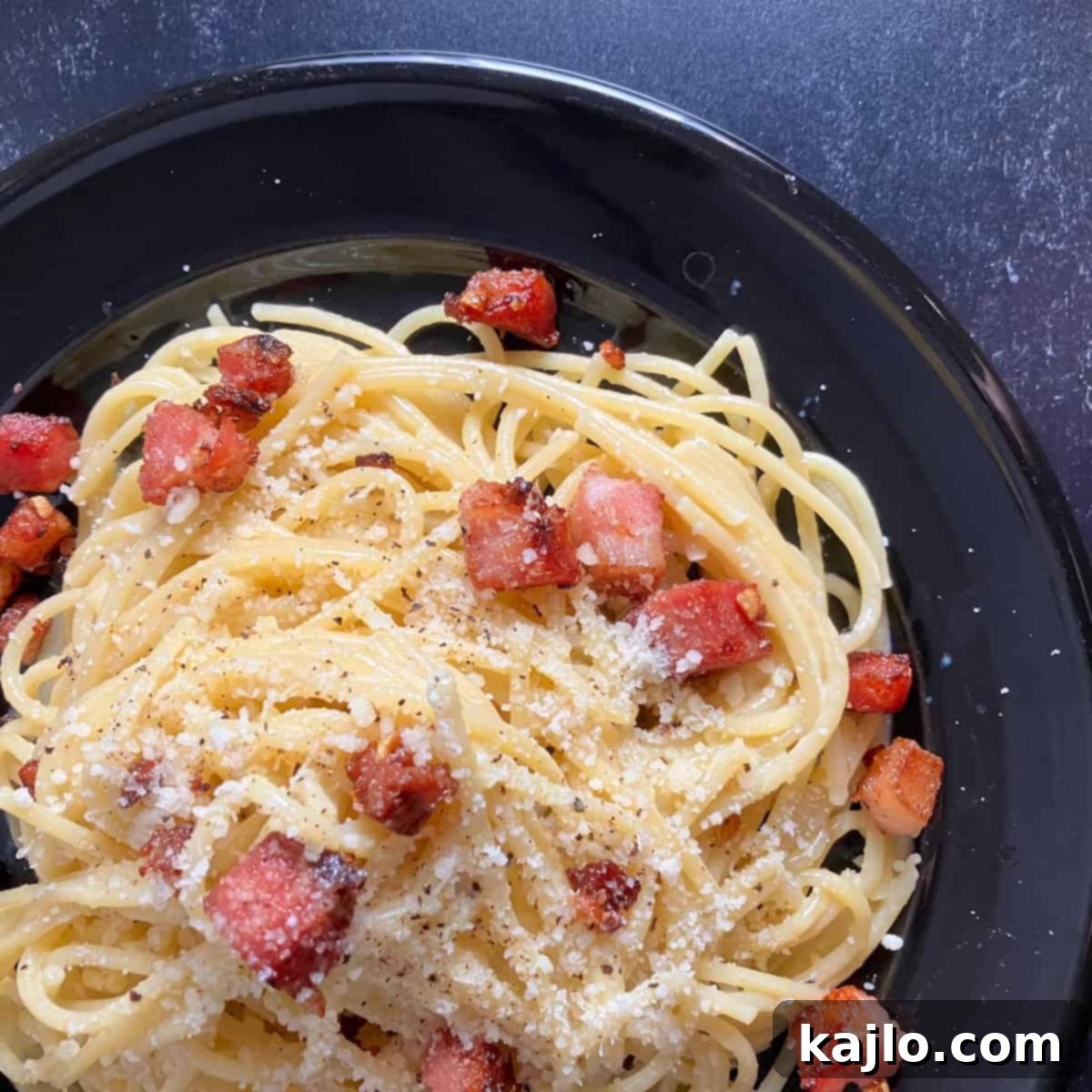
👩🏻🍳 Expand Your Culinary Repertoire: More Pork Belly Recipes
Once you’ve savored the delight of our crispy **Pork Belly Pasta**, you’ll undoubtedly be eager to explore more ways to enjoy this fantastic cut of meat. Pork belly is incredibly versatile, lending itself to a wide array of cuisines and cooking methods. Here are some other outstanding **pork belly recipes** to add to your rotation:
- Pork Belly Fried Rice: A phenomenal way to use leftover pork belly. Its crispy texture and rich flavor elevate a simple fried rice to gourmet status, making it a hearty and satisfying meal.
- Air Fryer Pork Belly: Achieve perfectly crispy pork belly with minimal effort and less mess. The air fryer is excellent for rendering fat and getting that desirable crackling skin, ideal for snacks or adding to various dishes.
- Pork Belly Ragu: A slow-cooked, deeply flavorful sauce where the pork belly melts into a rich tomato base. Perfect for pairing with hearty pasta shapes like bucatini or pappardelle.
Consider these additional simple Italian-inspired **belly pork main courses**: Create a vibrant **pork belly tomato pasta** by simmering your crispy pork belly in your favorite marinara or another robust tomato-based sauce. Alternatively, indulge in a luxurious **pork belly cream sauce** by incorporating the crispy meat into an American-style alfredo sauce. For an exciting Korean twist, add chopped kimchi to your pork belly pasta, offering a tangy and spicy kick.
Many of these pasta dishes, including our carbonara (with slight modifications), can also be transformed into a comforting **pork belly pasta bake** by finishing them in the oven with a layer of cheese, providing a wonderful variation to a stovetop preparation.
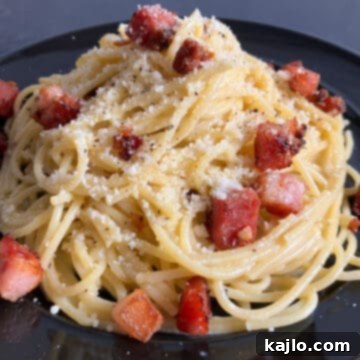
Pork Belly Pasta Recipe (Pork Belly Carbonara)
Summer Yule
Pork Belly Pasta is an easy recipe with just 5 simple ingredients (plus salt and pepper), transforming humble ingredients into a gourmet meal.
20 mins
20 mins
Dinner
American, Italian
4
569 kcal
Ingredients
- 4 ounces cooked pork belly (113 grams; precooked Costco pork belly or leftover crispy pork belly)
- 2 cloves garlic, minced
- 3 large eggs
- ⅔ cups grated Parmesan cheese, packed (plus more for serving)
- Salt and black pepper, to taste
- 12 ounces pasta, dry (340 grams spaghetti)
Instructions
- Dice the pork belly and mince the garlic. Cook the pork belly in a skillet over medium heat until crisp and fat is rendered. Add minced garlic and cook for another minute until fragrant.
- While pork belly cooks, whisk eggs, Parmesan, salt, and pepper in a large bowl. Set aside for the carbonara sauce.
- In a separate pot, boil salted water and cook pasta to al dente according to package directions (approx. 10 minutes for spaghetti).
- Drain pasta, reserving about one cup of pasta water. Return hot pasta to the pot and immediately stir in the egg mixture. Add reserved pasta water if needed to achieve a creamy sauce.
- Toss the crispy pork belly into the pasta. Serve immediately with extra Parmesan and fresh black pepper.
Equipment
- Cast Iron Skillet
- Whisk
- Pasta Pot
- Colander
Nutrition Info Disclaimer
All recipes on this website may or may not be appropriate for you, depending on your medical needs and personal preferences. Consult with a registered dietitian or your physician if you need help determining the dietary pattern that may be best for you.
The nutrition information provided is an estimate and courtesy. It will vary depending on the specific brands and ingredients used. Calorie information on food labels may also be inaccurate, so please don’t stress the numbers too much.
“To taste” refers to your personal preferences, but always ensure food safety rules are followed. Please do not consume undercooked food.
Nutrition
Carbohydrates: 66.2 g
Protein: 24.3 g
Fat: 22.9 g
Saturated Fat: 9.3 g
Fiber: 3.1 g
Vitamin A: 4.6 % DV
Calcium: 12.9 % DV
Iron: 21 % DV
Keywords
italian belly pork, italian pork belly, pork belly carbonara, pork belly carbonara recipe, pork belly pasta, pork belly pasta recipe, pork carbonara, easy pasta recipe, crispy pork belly, homemade carbonara, weeknight meal
Love this recipe? Please leave a comment below!
Shop our cookbook! Easy Air Fryer Recipes for One
Burning your air fryer recipes? Here’s how to fix it!
Join our community! Subscribe for all the latest and greatest recipes, and follow me on Facebook, Pinterest, Instagram, and YouTube!
